2020年山东专升本英语语法时态篇
专升本英语语法重点汇总
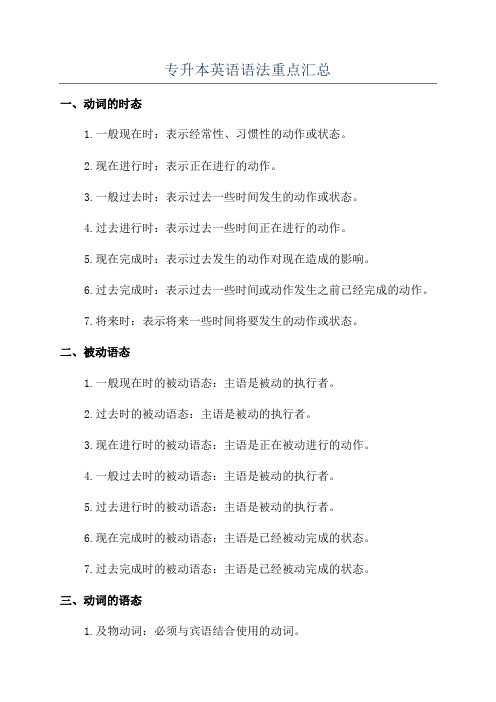
专升本英语语法重点汇总一、动词的时态1.一般现在时:表示经常性、习惯性的动作或状态。
2.现在进行时:表示正在进行的动作。
3.一般过去时:表示过去一些时间发生的动作或状态。
4.过去进行时:表示过去一些时间正在进行的动作。
5.现在完成时:表示过去发生的动作对现在造成的影响。
6.过去完成时:表示过去一些时间或动作发生之前已经完成的动作。
7.将来时:表示将来一些时间将要发生的动作或状态。
二、被动语态1.一般现在时的被动语态:主语是被动的执行者。
2.过去时的被动语态:主语是被动的执行者。
3.现在进行时的被动语态:主语是正在被动进行的动作。
4.一般过去时的被动语态:主语是被动的执行者。
5.过去进行时的被动语态:主语是被动的执行者。
6.现在完成时的被动语态:主语是已经被动完成的状态。
7.过去完成时的被动语态:主语是已经被动完成的状态。
三、动词的语态1.及物动词:必须与宾语结合使用的动词。
2.不及物动词:不需要与宾语结合使用的动词。
四、倒装句1.完全倒装:把助动词或情态动词放在主语前。
2.部分倒装:把助动词或情态动词放在谓语动词前。
五、情态动词1. can:表示能力、许可、可能。
2. could:表示过去的能力、许可、可能。
3. may:表示允许、可能。
4. might:表示过去可能。
5. must:表示推测、必须。
6. shall:表示将来的意愿。
7. should:表示建议、应该。
8. will:表示将来。
9. would:表示过去习惯、愿意。
六、名词1.可数名词:可以用来计数的名词。
2.不可数名词:不可以用来计数的名词。
3.特殊名词变复数形式。
4.特殊名词变单数形式。
七、形容词和副词1.形容词在句中的位置。
2.形容词比较级和最高级。
3.副词在句中的位置。
4.副词比较级和最高级。
五、代词1.主格代词:作为主语的代词。
2.宾格代词:作为宾语的代词。
3.物主代词:表示所属关系的代词。
4.反身代词:表示动作反过来作用于自己的代词。
专升本时态总结归纳

专升本时态总结归纳一、现在时态现在时态用于描述当前或经常性的动作、状态或普遍真理。
其构成为主语 + 动词的原形或动词的第三人称单数形式。
1. 基本用法现在时态直接描述现在发生的事情,常常与时间状语连用,如:now(现在)、every day(每天)、always(总是)等。
例如:- I often go to the gym after work.(我经常下班后去健身房。
)- She studies English every day.(她每天都学英语。
)2. 现阶段的状态或趋势现在时态也可以用于表示现阶段存在的状态或趋势。
例如:- The price of oil is rising.(油价正在上涨。
)- More and more people are using smartphones nowadays.(现如今越来越多的人在使用智能手机。
)3. 描述普遍真理现在时态还可以用于描述普遍真理、科学原理等不受时间限制的事实。
例如:- Water boils at 100 degrees Celsius.(水在100摄氏度时沸腾。
)- The sun rises in the east.(太阳从东方升起。
)二、过去时态过去时态(简称“过去时”)用于描述已经发生或完成的动作、情况或状态。
其构成为主语 + 动词的过去式。
1. 单纯的过去事件过去时态常用于描述已经发生的、与过去相关的事情。
例如:- I went to the cinema last night.(昨晚我去了电影院。
)- He studied English when he was in high school.(他在高中时学习英语。
)2. 过去经常性的动作过去时态也可以用于描述过去经常性发生的动作。
常与时间状语连用。
例如:- She always played basketball with her friends after school.(她放学后总是和朋友们一起打篮球。
专升本-英语时态考点整理

四. 一般将来时
表示将来某时间要发生的事或存在的状态,也可表示 将来经常或反复发生的动作,常与表示将来的时间状 语连用。表示方法多样: 1. will\shall do 将来的动作或状态 2. be going to do 最近打算要做的事或可能要发生 的事 3. be to do 必须按计划要进行的 4. be about to do 即将发生(不加将来的时间状语) 5. be doing (常与arrive, leave, come, start)
三. 一般过去时
常与以下时间状语连用:an hour ago, the other day, in 1987,last year... , just now, in those days 等。 表示:过去某个时间发生或存在的动作、过去经 常发生或偶尔发生的动作。
常见考点如下: 1. 在It is time that...(某人该做某事了)的that 从句中的谓语动词用过去时。E.g. It is time that you went to bed.= It is time for you to go to bed. 2. 注意区分used to do (过去常做)和 get\be\become used to doing sth. (习惯于做 某事) (20005) My sister is used to _______ with all the windows open. A. sleep B. have slept C. sleeping D. Slept
七.过去进行时
表示过去某时刻正在进行的动作。 与always, constantly,forever等状语连用时带有感情 色彩,如:She was always finding fault with me. 她总是挑我的毛病。Biblioteka Grammar Test 1
2020年专升本英语动词时态模拟试题【考前必看】
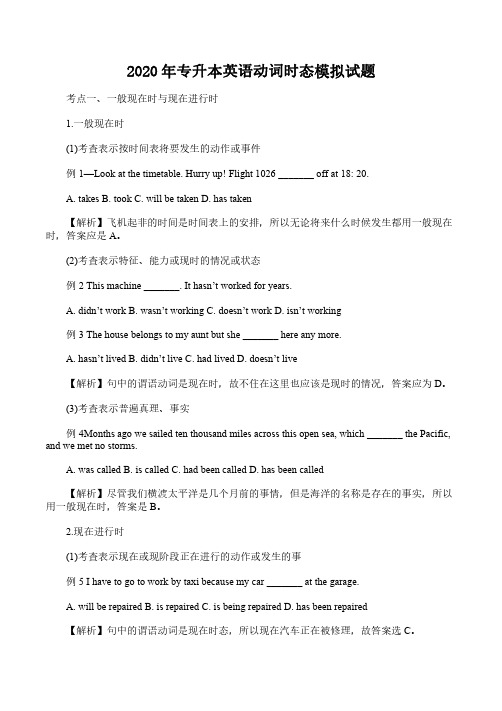
2020年专升本英语动词时态模拟试题考点一、一般现在时与现在进行时1.一般现在时(1)考查表示按时间表将要发生的动作或事件例1—Look at the timetable.Hurry up!Flight1026_______off at18:20.A.takesB.tookC.will be takenD.has taken【解析】飞机起非的时间是时间表上的安排,所以无论将来什么时候发生都用一般现在时,答案应是A。
(2)考查表示特征、能力或现时的情况或状态例2This machine_______.It hasn’t worked for years.A.didn’t workB.wasn’t workingC.doesn’t workD.isn’t working例3The house belongs to my aunt but she_______here any more.A.hasn’t livedB.didn’t liveC.had livedD.doesn’t live【解析】句中的谓语动词是现在时,故不住在这里也应该是现时的情况,答案应为D。
(3)考查表示普遍真理、事实例4Months ago we sailed ten thousand miles across this open sea,which_______the Pacific, and we met no storms.A.was calledB.is calledC.had been calledD.has been called【解析】尽管我们横渡太平洋是几个月前的事情,但是海洋的名称是存在的事实,所以用一般现在时,答案是B。
2.现在进行时(1)考查表示现在或现阶段正在进行的动作或发生的事例5I have to go to work by taxi because my car_______at the garage.A.will be repairedB.is repairedC.is being repairedD.has been repaired【解析】句中的谓语动词是现在时态,所以现在汽车正在被修理,故答案选C。
专升本英语语法:16种英语时态(用法+例句)
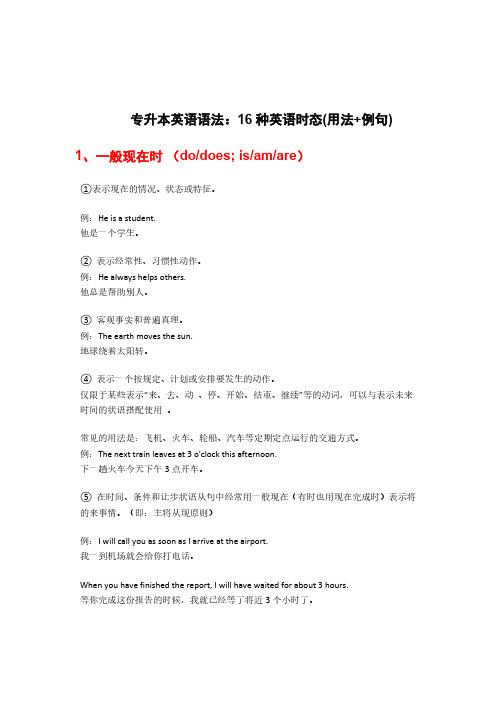
专升本英语语法:16种英语时态(用法+例句)1、一般现在时(do/does;is/am/are)①表示现在的情况、状态或特征。
例:He is a student.他是一个学生。
②表示经常性、习惯性动作。
例:He always helps others.他总是帮助别人。
③客观事实和普遍真理。
例:The earth moves the sun.地球绕着太阳转。
④表示一个按规定、计划或安排要发生的动作。
仅限于某些表示“来、去、动、停、开始、结束、继续”等的动词,可以与表示未来时间的状语搭配使用。
常见的用法是:飞机、火车、轮船、汽车等定期定点运行的交通方式。
例:The next train leaves at3o'clock this afternoon.下一趟火车今天下午3点开车。
⑤在时间、条件和让步状语从句中经常用一般现在(有时也用现在完成时)表示将的来事情。
(即:主将从现原则)例:I will call you as soon as I arrive at the airport.我一到机场就会给你打电话。
When you have finished the report,I will have waited for about3hours.等你完成这份报告的时候,我就已经等了将近3个小时了。
2、现在进行时(am/is/are doing)①表示此时此刻正在发生的事情。
例:He is listning to the music now.他现在正在听音乐。
②表示目前一段时间内一直在做的事情,但不一定此时此刻正在做。
例:I am studying computer this term.这个学期我一直在学习计算机。
③现在进行时可以表示将来的含义。
a.瞬时动词的进行一定表将来。
例:I am leaving.我要离开了。
b.持续动词的进行只有有将来的时间状语或有将来语境中才表将来。
例:I am travelling next month.下个月我要去旅行。
英语专升本语法知识点汇总

英语专升本语法知识点汇总一、时态。
1. 一般现在时。
- 用法:- 表示经常或习惯性的动作或存在的状态。
例如:I go to school by bike every day.(我每天骑自行车去上学。
)- 表示客观事实或普遍真理。
例如:The earth moves around the sun.(地球绕着太阳转。
)- 结构:- 主语为第三人称单数(he/she/it等)时,动词要加 -s或 -es,如He likes reading. 其他人称用动词原形,如I like reading.2. 一般过去时。
- 用法:- 表示过去某个时间发生的动作或存在的状态。
例如:I visited my grandparents last weekend.(我上周末去看望了我的祖父母。
)- 结构:- 动词一般用过去式形式。
规则动词的过去式一般在词尾加 -ed,如work - worked;不规则动词有其特殊的过去式形式,如go - went。
3. 一般将来时。
- 用法:- 表示将来某个时间要发生的动作或存在的状态。
例如:I will go to Beijing next month.(我下个月将去北京。
)- 结构:- 常见的结构有will+动词原形,be going to+动词原形(表示计划、打算做某事或有迹象表明即将发生某事)。
如He is going to have a party tonight.(他今晚打算举办一个聚会。
)4. 现在进行时。
- 用法:- 表示现在正在进行的动作或存在的状态。
例如:She is reading a book now.(她现在正在读一本书。
)- 结构:- be动词(am/is/are)+动词的 -ing形式。
5. 过去进行时。
- 用法:- 表示过去某个时刻或某段时间正在进行的动作。
例如:I was watching TV at 8 o'clock last night.(昨晚8点我正在看电视。
山东专升本语法知识点总结

山东专升本语法知识点总结在山东专升本的英语考试中,语法知识点是考生必须掌握的基础。
以下是对一些关键语法点的总结,帮助考生进行复习和巩固。
1. 时态和语态时态和语态是英语语法中的重要部分。
考生需要掌握各种时态的构成和用法,如一般现在时、一般过去时、一般将来时、现在进行时、过去进行时、现在完成时、过去完成时等。
同时,也应了解被动语态的构成和使用场景。
2. 非谓语动词非谓语动词包括不定式、动名词和分词。
不定式通常用于表示目的、原因、结果等,动名词则表示抽象或经常性的动作,分词则用于表示进行或完成的动作。
考生需要掌握它们的不同用法和构成。
3. 虚拟语气虚拟语气用于表示非现实或假设的情况。
考生需要掌握虚拟语气在条件句、建议、命令、愿望等语境中的用法。
4. 定语从句定语从句用于修饰名词或代词,通常由关系代词或关系副词引导。
考生需要掌握关系代词和关系副词的用法,以及如何根据先行词选择正确的关系词。
5. 名词性从句名词性从句包括主语从句、宾语从句、表语从句和同位语从句。
考生需要了解它们在句子中的作用,以及如何根据上下文选择合适的连词。
6. 状语从句状语从句用于表示时间、地点、原因、目的、结果、条件、让步等。
考生需要掌握各种状语从句的构成和使用。
7. 直接引语和间接引语直接引语是直接引用别人的话,而间接引语则是转述别人的话。
考生需要掌握如何将直接引语转换为间接引语,以及注意时态和人称的变化。
8. 情态动词情态动词如can, could, may, might, must, shall, should等,用于表示能力、请求、许可、义务、推测等。
考生需要掌握它们的用法和区别。
9. 比较级和最高级比较级和最高级用于表示事物之间的差异。
考生需要掌握比较级和最高级的构成,以及如何使用它们进行比较。
10. 冠词的使用冠词包括不定冠词a/an和定冠词the。
考生需要掌握冠词的使用规则,如特指和泛指的区别,以及在固定搭配中的使用。
专升本英语语法知识点精讲
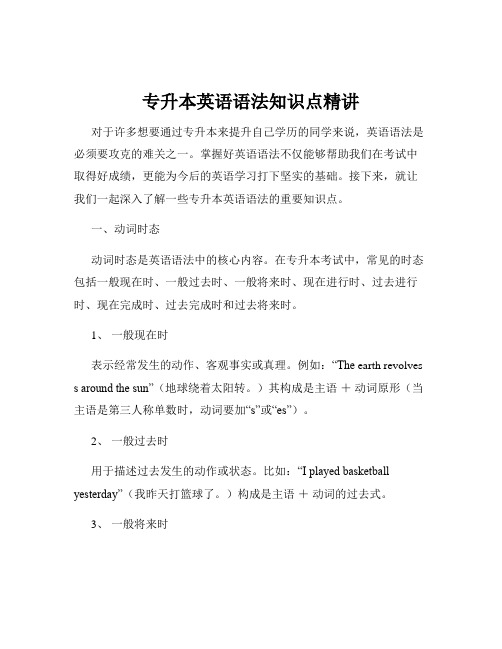
专升本英语语法知识点精讲对于许多想要通过专升本来提升自己学历的同学来说,英语语法是必须要攻克的难关之一。
掌握好英语语法不仅能够帮助我们在考试中取得好成绩,更能为今后的英语学习打下坚实的基础。
接下来,就让我们一起深入了解一些专升本英语语法的重要知识点。
一、动词时态动词时态是英语语法中的核心内容。
在专升本考试中,常见的时态包括一般现在时、一般过去时、一般将来时、现在进行时、过去进行时、现在完成时、过去完成时和过去将来时。
1、一般现在时表示经常发生的动作、客观事实或真理。
例如:“The earth revolves s around the sun”(地球绕着太阳转。
)其构成是主语+动词原形(当主语是第三人称单数时,动词要加“s”或“es”)。
2、一般过去时用于描述过去发生的动作或状态。
比如:“I played basketball yesterday”(我昨天打篮球了。
)构成是主语+动词的过去式。
3、一般将来时表示将来要发生的动作,常见的表达有“will +动词原形”和“be going to +动词原形”。
例如:“I will go to Beijing next week” (我下周要去北京。
)4、现在进行时表示正在进行的动作,结构为“be +现在分词”。
如:“She is reading a book now”(她现在正在读书。
)5、过去进行时强调过去某个时刻正在进行的动作,“was/were +现在分词”是其构成形式。
像:“I was watching TV at 8 o'clock last night” (昨晚八点我正在看电视。
)6、现在完成时表示过去发生的动作对现在造成的影响或结果,或者从过去开始一直持续到现在的动作。
“have/has +过去分词”为其结构。
例如:“I have learned English for five years”(我学英语已经五年了。
)7、过去完成时在过去某个时间点之前已经完成的动作,由“had +过去分词”构成。
专升本英语-时态

专升本英语-时态专升本英语时态在专升本英语的学习中,时态是一个至关重要的语法知识点。
掌握好时态,对于准确、清晰地表达英语句子的含义有着不可或缺的作用。
首先,让我们来了解一下什么是时态。
时态简单来说,就是表示动作发生的时间和状态。
英语中常见的时态有一般现在时、一般过去时、一般将来时、现在进行时、过去进行时、现在完成时、过去完成时等等。
一般现在时,这是我们最常见也最基础的时态之一。
它通常用于表示习惯性的动作、客观事实、真理等。
比如,“The sun rises in the east”(太阳从东方升起。
)这就是一个客观事实,所以用一般现在时。
再比如,“I often go for a walk after dinner”(我经常晚饭后去散步。
)这里表示的是一种习惯性的动作。
一般过去时呢,则是用来描述过去发生的动作或存在的状态。
“I went to Beijing last year”(我去年去了北京。
)在这个句子中,“went”就是“go”的过去式,表明去北京这个动作发生在过去。
而一般将来时,顾名思义,是用于表示将来要发生的动作或存在的状态。
“I will go to the library tomorrow”(我明天会去图书馆。
)“will+动词原形”是一般将来时常见的结构。
现在进行时,强调的是正在进行的动作。
“She is reading a book now”(她现在正在读一本书。
)“be +动词的现在分词”构成了现在进行时。
过去进行时,用于描述过去某个时刻正在进行的动作。
“I was watching TV at 8 o'clock last night”(昨晚 8 点我正在看电视。
)现在完成时,表示过去发生的动作对现在造成的影响或结果,或者过去的动作一直持续到现在。
“I have finished my homework”(我已经完成了我的作业。
)过去完成时,相对复杂一些,它表示过去某一时间或动作之前已经发生或完成了的动作。
专升本英语语法十五要点
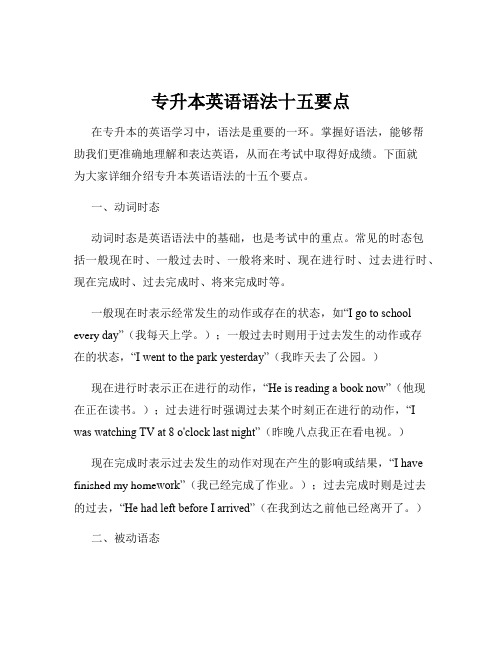
专升本英语语法十五要点在专升本的英语学习中,语法是重要的一环。
掌握好语法,能够帮助我们更准确地理解和表达英语,从而在考试中取得好成绩。
下面就为大家详细介绍专升本英语语法的十五个要点。
一、动词时态动词时态是英语语法中的基础,也是考试中的重点。
常见的时态包括一般现在时、一般过去时、一般将来时、现在进行时、过去进行时、现在完成时、过去完成时、将来完成时等。
一般现在时表示经常发生的动作或存在的状态,如“I go to school every day”(我每天上学。
);一般过去时则用于过去发生的动作或存在的状态,“I went to the park yesterday”(我昨天去了公园。
)现在进行时表示正在进行的动作,“He is reading a book now”(他现在正在读书。
);过去进行时强调过去某个时刻正在进行的动作,“I was watching TV at 8 o'clock last night”(昨晚八点我正在看电视。
)现在完成时表示过去发生的动作对现在产生的影响或结果,“I have finished my home work”(我已经完成了作业。
);过去完成时则是过去的过去,“He had left before I arrived”(在我到达之前他已经离开了。
)二、被动语态被动语态在英语中使用广泛,其基本构成是“be +过去分词”。
例如,“The book is written by him”(这本书是他写的。
)需要注意的是,不同时态的被动语态形式有所不同,要牢记各种时态下被动语态的构成。
三、非谓语动词非谓语动词包括动词不定式、动名词和分词(现在分词和过去分词)。
动词不定式常用来表示目的、将来等,“I want to go shopping”(我想去购物。
)动名词具有名词的性质,“Swimming is my favorite sport”(游泳是我最喜欢的运动。
)现在分词表示主动和进行,过去分词表示被动和完成。
2024年山东专升本英语考试真题及答案
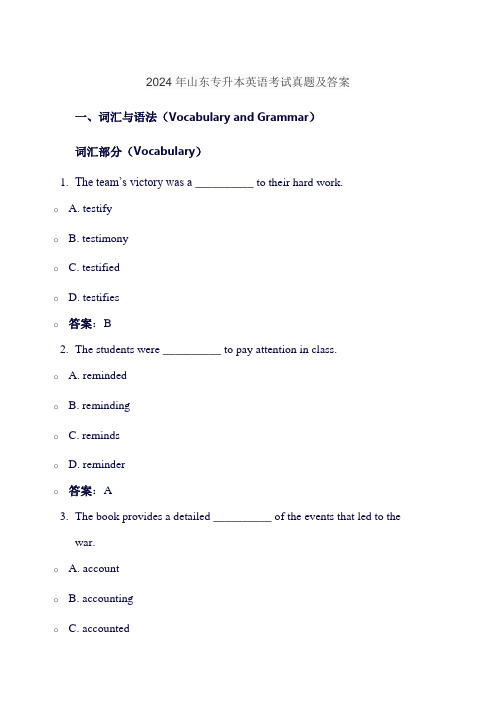
2024年山东专升本英语考试真题及答案一、词汇与语法(Vocabulary and Grammar)词汇部分(Vocabulary)1.The team’s victory was a__________ to their hard work.o A. testifyo B. testimonyo C. testifiedo D. testifieso答案:B2.The students were __________ to pay attention in class.o A. remindedo B. remindingo C. remindso D. remindero答案:A3.The book provides a detailed __________ of the events that led to thewar.o A. accounto B. accountingo C. accountedo D. accountso答案:A4.The teacher __________ the students to follow the instructions carefully. o A. remindedo B. remindo C. remindingo D. remindero答案:A5.The athlete broke the world record, __________ his dominance in thesport.o A. illustrateo B. illustrativeo C. illustratedo D. illustrateso答案:D(但根据前文提供的答案,此处应为C作为过去时的示例,可能是个例外或特定语境下的用法,但通常“illustrates”作为第三人称单数现在时是正确的形式。
不过,按照给出的参考答案,我们采用C。
)语法部分(Grammar)6.My friend and I __________ going to the concert tonight.o A. iso B. areo C. amo D. will beo答案:B7.She __________ her job last month.o A. leaveo B. lefto C. leaveso D. leavingo答案:B8.The concert __________ by the time we arrived.o A. had finishedo B. finishedo C. finisheso D. finishingo答案:A9.I wish I __________ more time to study for the exam. o A. hado B. haveo C. haso D. will haveo答案:A10.H e asked me __________ the report by Friday.o A. finisheso B. finishedo C. finisho D. finishingo答案:C二、阅读理解(Reading Comprehension)以下仅提供部分阅读理解题目的示例及参考答案:示例一When it comes to air travel, the safest seats may not be those that are the best for the passengers. Instead, according to new research, the safest place is below the cockpit -- the spot on the plane where you are visible to the pilot and can see right through him.(词汇填空题,已给出答案选项并略去,实际考试中需从给定词列表中选词填空)示例二Passage: Climate change is a pressing issue that affects the entire planet. Rising temperatures, extreme weather events, and melting ice caps are just a few examples of the impact of climate change. Itis crucial that we take action to reduce our carbon footprint andprotect the environment for future generations.Questions:1.What are some examples of the impact of climate change?o答案:Rising temperatures, extreme weather events, and melting ice caps.2.Why is it important to take action to combat climate change?o答案:It is important to protect the environment for future generations. 3.What can individuals do to reduce their carbon footprint?o答案:Individuals can reduce their carbon footprint by using public transportation, conserving energy, and recycling.三、写作(Writing)以下是一个写作题目的示例及参考答案框架:Topic: Should college education be free for all students?Proponents argue that free college education would open doors for all students to pursue their dreams, regardless of their financialsituation. They believe that education is a right, not a privilege, and should be accessible to everyone. Additionally, they argue that by investing in education, the government is investing in the future of the country.On the other hand, opponents argue that free college education would be too costly for the government to sustain. They also argue that making college education free for all students would devalue the importance of a college degree. Furthermore, they believe that students should have some financial responsibility for their education to motivate them to take their studies seriously.参考答案框架:In my opinion, college education should not be entirely free for all students. 此处可展开论述个人观点,包括支持或反对的理由,以及可能的解决方案或建议。
专升本英语十六种时态结构表

专升本英语十六种时态结构表以下是专升本英语十六种时态结构表:时态结构例句一般现在时do/does I study English every day.现在进行时am/is/are doing He is watching TV now.现在完成时have/has done I have finished my homework.现在完成进行时have/has beendoingShe has been learning English for fiveyears.一般过去时did We went to the park yesterday.过去进行时was/were doingThey were playing football when Iarrived.过去完成时had doneBy the end of last month, I had finishedthe project.过去完成进行时had been doingShe had been working on the report forthree hours.一般将来时will/shall do I will go to the party tomorrow.将来进行时will/shall bedoingThey will be studying at university nextyear.将来完成时will/shall havedoneBy this time next year, I will havegraduated from college.将来完成进行时will/shall havebeen doingI will have been studying for eighthours by the time you arrive.时态结构例句过去将来时would/should do He said he would come back the next day.过去将来进行时would/should bedoingShe said she would be working on theproject at that time.过去将来完成时would/shouldhave doneHe said he would have finished the workby the end of the week.过去将来完成进行时would/shouldhave been doingShe said she would have been working onthe project for a month by then.以上是英语十六种时态的结构和例句,希望对你有所帮助。
专升本英语时态知识点总结

专升本英语时态知识点总结时态是英语语法中的一个重要组成部分,它表示动作发生的时间。
掌握时态的正确使用对于提高英语语言能力是至关重要的。
下面是专升本英语时态知识点的总结。
一、一般现在时1.表示经常性、习惯性的动作或事实。
2.表示客观真理、自然规律等。
3. 在主语为第三人称单数的情况下,动词需加-s或-es。
二、一般过去时1.表示过去一些时间发生的动作或事实。
2.在句子中常与表示过去的时间状语连用。
三、一般将来时1.表示将来一些时间还未发生的动作或事实。
2.常与将来的时间状语连用。
四、现在进行时1.表示现在正在进行的动作。
2. be动词+动词-ing形式构成。
五、过去进行时1.表示过去一些时间正在进行的动作。
2. was/were+动词-ing形式构成。
六、将来进行时1.表示将来一些时间将会进行的动作。
2. will be+动词-ing形式构成。
七、现在完成时1.表示过去发生的动作对现在造成的影响。
2. have/has+过去分词构成。
3.常与表示过去到现在的时间段连用。
八、过去完成时1.表示过去一些时间之前已经完成的动作。
2. had+过去分词构成。
九、将来完成时1.表示将在将来一些时间之前完成的动作。
2. will have+过去分词构成。
十、一般将来时1.表示将来一些时间发生的动作或事实。
2. 助动词shall/will+动词原形构成。
3. shall一般用于第一人称(I、we)。
4. will一般用于第二、第三人称(you、he、she、it、they)。
十一、现在完成进行时1.表示过去开始持续到现在,并可能继续进行下去的动作。
2. have/has been+动词-ing形式构成。
以上是关于专升本英语时态知识点的总结。
掌握了这些知识点,可以帮助我们准确地表达动作发生的时间和情况。
在日常学习和使用中,需要多加练习,通过不断的实践来熟练掌握时态的使用。
专升本英语语法知识点归纳

专升本英语语法知识点归纳专升本英语语法知识点归纳在专升本英语考试中,语法知识点是必考内容。
本文将为大家梳理常见的英语语法知识点,帮助大家更好地掌握英语语法,提高考试成绩。
一、时态时态是英语语法中非常重要的一个部分,主要涉及过去、现在和未来的时间表达。
以下是常见的时态及其用法:1、现在完成时:表示过去发生的动作对现在造成影响或结果。
例如:I have finished my homework.(我已经完成了我的作业。
)2、现在进行时:表示正在进行的动作。
例如:They are playing soccer.(他们正在踢足球。
)3、一般现在时:表示通常性、规律性发生的动作或状态。
例如:She goes to school every day.(她每天上学。
)4、一般过去时:表示过去的动作或状态。
例如:He lived in New York for three years.(他在纽约住了三年。
)5、一般将来时:表示将来发生的动作或状态。
例如:We will meet at the airport tomorrow.(我们明天将在机场见面。
)二、语态语态表示动词的形式,表明动作的执行者和承受者。
以下是常见的语态及其用法:1、主动语态:表示主语是动作的执行者。
例如:The dog bit the cat.(狗咬了猫。
)2、被动语态:表示主语是动作的承受者。
例如:The cat was bit by the dog.(猫被狗咬了。
)三、虚拟语气虚拟语气是一种特殊的语气,表示假设、猜测、愿望或建议。
以下是常见的虚拟语气及其用法:1、与现在事实相反的虚拟语气:使用过去时形式,表示与现在事实相反的假设。
例如:If I had a million dollars, I would buy a house.(如果我有一百万美元,我会买一栋房子。
)2、与过去事实相反的虚拟语气:使用过去完成时形式,表示与过去事实相反的假设。
专升本英语动词时态知识点大全

专升本英语动词时态知识点大全在专升本英语的学习中,动词时态是一个至关重要的知识点。
掌握好动词时态,不仅能够帮助我们正确理解和表达英语,还能在各种考试中取得优异的成绩。
接下来,让我们一起深入了解一下专升本英语中常见的动词时态。
一、一般现在时一般现在时表示经常发生的动作、存在的状态或者普遍真理。
其基本结构是:主语+动词原形(当主语是第三人称单数时,动词要加“s”或“es”)。
例如:“I play basketball every day”(我每天都打篮球。
)“He likes music”(他喜欢音乐。
)一般现在时常用于以下情况:1、表示经常性或习惯性的动作,常与 often, usually, always, sometimes 等时间状语连用。
2、表示现在的状态或特征,如“ I am a student”(我是一名学生。
)3、表示客观事实和普遍真理,例如“ The earth moves around the sun”(地球绕着太阳转。
)二、一般过去时一般过去时表示过去某个时间发生的动作或存在的状态。
其基本结构是:主语+动词的过去式。
例如:“I went to Beijing last year”(我去年去了北京。
)“She was happy yesterday”(她昨天很开心。
)一般过去时通常与表示过去的时间状语连用,如:yesterday, last week, ago, in 1990 等。
三、一般将来时一般将来时表示将来要发生的动作或存在的状态。
其常见的结构有:1、“will +动词原形”,例如:“I will visit my grandparents next weekend”(我下周末将去看望我的祖父母。
)2、“be g oing to +动词原形”,强调计划、打算做某事,如:“Sheis going to study abroad next year”(她打算明年出国留学。
)四、现在进行时现在进行时表示正在进行的动作。
专升本英语时态知识点总结

专升本英语时态知识点总结一、一般时态1.一般现在时一般现在时用来表示当前的习惯或经常发生的动作,以及普遍真理和科学事实。
它的构成是主语+动词原形。
例如:She eats breakfast every morning.2.一般过去时一般过去时用来表示过去某个时间或一段时间里发生的动作。
它的构成是主语+动词过去式。
例如:She went to school yesterday.3.一般将来时一般将来时用来表示将来某个时间或一段时间里将要发生的动作。
它的构成是将来时助动词will/shall+动词原形。
例如:She will go to the park tomorrow.二、进行时态1.现在进行时现在进行时用来表示现在正在进行的动作。
它的构成是be动词(am/is/are)+动词的现在分词。
例如:She is reading a book.2.过去进行时过去进行时用来表示过去某个时间点或一段时间里正在进行的动作。
它的构成是过去时的be动词(was/were)+动词的现在分词。
例如:She was watching TV when the phone rang.3.将来进行时将来进行时用来表示将来某个时间点或一段时间里将会正在进行的动作。
它的构成是将来时的be动词(will be)+动词的现在分词。
例如:She will be studying at 8 o'clock tomorrow.三、完成时态1.现在完成时现在完成时用来表示过去某时发生的动作对现在产生的影响。
它的构成是have/has+动词的过去分词。
例如:She has finished her homework.2.过去完成时过去完成时用来表示过去某个时间或一段时间里发生的动作之前已经发生的动作。
它的构成是过去完成时的have/has+动词的过去分词。
例如:She had already left when the party started.3.将来完成时将来完成时用来表示将来某个时间或一段时间里将会发生的动作之前已经发生的动作。
- 1、下载文档前请自行甄别文档内容的完整性,平台不提供额外的编辑、内容补充、找答案等附加服务。
- 2、"仅部分预览"的文档,不可在线预览部分如存在完整性等问题,可反馈申请退款(可完整预览的文档不适用该条件!)。
- 3、如文档侵犯您的权益,请联系客服反馈,我们会尽快为您处理(人工客服工作时间:9:00-18:30)。
山东专升本英语语法时态篇(基础)第一章时态英语中谓语动词的时态(Tense)是一种动词的形式,不同的时态用以表示在不同的时间完成的动作或保持的状态。
英语动词共有十六种时态,这里将重点讲解其中较常用的十种时态。
一、一般现在时( The Present Indefinite Tense)1. 用于表示客观事实, 现在反复发生或习惯性的动作以及存在的特征、状态等,常与often, always, sometimes, usually, once a week, every day, seldom等时间状语连用。
【例句】The earth revolves around the sun.The students get up at six thirty every morning.2.表示按计划或安排好的将来的动作,常使用arrive, be, go, start, stay等动词。
【例句】There is a dancing party tonight.The plane arrives in Beijing at three this afternoon.3.用在以as soon as, when, after, while, as, until, till, whenever, the monment,theminute, immediately, directly等引导的时间状语从句中或以if, unless, as/so long as, in case, provided that等引导的条件状语从句中,代替一般将来时。
【例句】I’ll ring you as soon as he comes back.If it is fine tomorrow we will go swimming.The machine starts running the moment the button is pressed.注:if条件句中,有will出现时,will是情态动词,意义为“愿意”,“肯”。
二、一般过去时( The Past Indefinite Tense)一般过去时用于表示过去某时刻或某一时期内的动作或状态, 也可表示过去习惯性的动作。
常与表明过去时间的状语连用,如yesterday, then, just now, last month, two days ago, in 1990, 或由when或while等引导的表明过去时间的状语从句。
【例句】We met him last week.Where did you live when you were young?He used to do fourteen hours a day.●提示:一般过去时不强调动作对现在的影响,只说明过去。
三、一般将来时(The Future Indefinite Tense)一般将来时用来表示将来某个时间会发生的动作或情况,也可表示将来反复发生的动作或习惯性的动作。
【例句】We shall (will) go to Nanjing tomorrow morning.He will take part in an important race across the Atlantic.The students will have five English classes per week this term.●提示:表示将来时态的其他形式与用法:1.“be going to +动词原形”表示(能看出迹象)很快就要发生的事情或打算要做的事。
It is going to rain.2.“be to +动词原形”表示安排好的动作或安排别人去做的事。
They are to meet in front of the hall.You are not to bring any materials to the exam room.3.“be about to +动词原形”表示即将发生的或正要做的事。
The conference is about to begin.4.“be +现在分词”有时可表示按计划即将发生的一个动作,但仅适用于少数的一些动词(如arrive, come, go, leave, start等)而且常跟表示较近将来的时间状语连用。
My friend is arriving here the day after tomorrow.●提示:在美国英语中第一、二、三人称都用“wi ll+动词原形”四、现在进行时(The Present Continuous Tense)现在进行时表示此刻或现阶段正在进行的动作。
但表示后一种情况时,动作此刻不一定正在进行。
【例句】We are making an experiment now.Steve is studying Chinese in Beijing.另外,现在进行时也可用来给习惯动作加上赞赏或讨厌等感情色彩。
【例句】He is always cooking some delicious food for her family.He is always finding fault with his employees.●提示:并非所有动词都有进行时,有些表示状态和感觉的动词通常无进行时,除非这类动词的词义发生变化。
这类动词有: be, love, like, hate, believe, think(认为), feel, seem等。
【例句】Do you see anyone over there?Are you seeing someone off? (see… off 意为“为…送行”)五、过去进行时(The Past Continuous Tense)过去进行时表示过去某一时刻正在发生的动作,或过去某阶段内正在发生或反复发生的动作。
通常带有一个表示过去时间的状语或状语从句或能通过上下文判断的过去时间。
【例句】We were having a preparatory meeting at two-thirty yesterday afternoon.She was writing a composition when you came in.Bill was coughing all night long.六、将来进行时(The Future Continuous Tense)将来进行时表示将来某时可能正在发生或持续的动作。
【例句】I’ll be reading this time tomorrow.Most of the young people in the town will be meeting them at the station.七、现在完成时(The Present Perfect Tense)现在完成时表示目前已完成或刚刚完成的动作,也可以表示从过去某一时刻发生,现在仍延续着的动作或情况。
经常与for+一段时间或与since(+时间一点)引导的短语或从句连用,也可与一些表示不确定过去时间的副词连用,如already, before, ever, never, just, once, recently, yet, up to now, so far, thus far, up till/to now, in the last/past few years等。
【例句】We have been to Shanghai once.They have already finished the task.He has studied English for more than 10 years.He has studied English since 1991/ since he was twelve.So far everything has been successful.八、过去完成时(The Past Perfect Tense)过去完成时表示过去某一时刻或动作之前已经完成的动作。
在时间上,它属于“过去的过去”。
在句中常有明显的参照动作或有表示“到过去某时为止”的时间状语,如by, before等介词或连词引导的短语或状语从句。
【例句】By the end of the war, the small workshop had become a large factory.The plane had taken off before we got to the airport.They found that a stream had formed in the field.●提示:在由after, as soon as, before等连词引导状语从句的复合句中,由于连词本身已明确动作发生的次序,所以,这个从句也可以用一般过去时表示,不一定用过去完成时。
【例句】Students went out after the bell rang.I informed him of the progress of the work as soon as I arrived here.●提示:在It is/ was the first/second/last time that …句型中,that后的从句谓语用现在/过去完成时。
【例句】Is it the first time you’ve visited the city?That was the second time that I’d visited England that year.九、将来完成时(The Future Perfect Tense)将来完成时表示将来某时前将已经完成的动作,也可以用来表示推测。
【例句】By this time next year they will have built a hotel here.Hurry up! Or the train will have left before we get to the station.十、现在完成进行时(The Present Perfect Continuous Tense)现在完成进行时表示从过去某时开始,一直持续到现在的动作。
此动作或情况可能已停止,也可能继续下去。
但强调到说话时为止一直在进行的动作。
【例句】They have been working for IBM for 15 years.I have been waiting for an hour but she still hasn’t come.有些动词如play, stay, study, teach, wait等,在表示一直继续到现在的动作时,可以用现在完成进行时,或用现在完成时。
